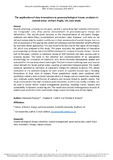JavaScript is disabled for your browser. Some features of this site may not work without it.
| dc.contributor.author | Rumson, Alexander G. | |
| dc.contributor.author | Hallett, Stephen H. | |
| dc.contributor.author | Brewer, Timothy R. | |
| dc.date.accessioned | 2019-08-23T08:34:12Z | |
| dc.date.available | 2019-08-23T08:34:12Z | |
| dc.date.issued | 2019-07-20 | |
| dc.identifier.citation | Rumson A, Hallett SH, Brewer TR. (2019) The application of data innovations to geomorphological impact analyses in coastal areas: An East Anglia, UK, case study. Ocean and Coastal Management, Volume 181, November 2019, Article number 104875 | en_UK |
| dc.identifier.issn | 0964-5691 | |
| dc.identifier.uri | https://doi.org/10.1016/j.ocecoaman.2019.104875 | |
| dc.identifier.uri | http://dspace.lib.cranfield.ac.uk/handle/1826/14461 | |
| dc.description.abstract | Rapidly advancing surveying technologies, capable of generating high resolution bathymetric and topographic data, allow precise measurements of geomorphological change and deformation. This permits great accuracy in the characterisation of volumetric change, sediment and debris flows, accumulations and erosion rates. However, such data can be utilised inadequately by coastal practitioners in their assessments of coastal change, due to a lack of awareness of the appropriate analytical techniques and the potential benefits offered by such data-driven approaches. This was found to be the case for the region of East Anglia, UK, which was analysed in this study. This paper evaluates the application of innovative geomorphological change detection (GCD) techniques for analysis of coastal change. The first half of the paper contains an extensive review of GCD methods and data sources used in previous studies. This leads to the selection and recommendation of an appropriate methodology for calculation of volumetric GCD, which has been subsequently applied and evaluated for 14 case study sites in East Anglia. This has involved combining open source point cloud datasets for broad spatial scales, covering an extended temporal period. The results comprise quantitative estimates of volumetric change for selected locations. This allows estimation of the sediment budgets for each stretch of coastline focused upon, revealing fluctuations in their rates of change. These quantitative results were combined with qualitative outputs, such as visual representations of change and we reveal how combining such methods assists identification of patterns and impacts linked to specific events. The study demonstrates how high-resolution point cloud data, which is now readily available, can be used to better inform coastal management practices, revealing trends, impacts and vulnerability in dynamic coastal regions. The results also indicate heterogeneous impacts of events, such as the 2013 East Coast Storm Surge, across the study area of East Anglia. | en_UK |
| dc.language.iso | en | en_UK |
| dc.publisher | Elsevier | en_UK |
| dc.rights | Attribution-NonCommercial-NoDerivatives 4.0 International | * |
| dc.rights.uri | http://creativecommons.org/licenses/by-nc-nd/4.0/ | * |
| dc.subject | Geomorphological change detection | en_UK |
| dc.subject | Coastal management | en_UK |
| dc.subject | Open source data | en_UK |
| dc.subject | Point cloud data | en_UK |
| dc.subject | Volumetric change | en_UK |
| dc.subject | Impact analysis | en_UK |
| dc.title | The application of data innovations to geomorphological impact analyses in coastal areas: An East Anglia, UK, case study | en_UK |
| dc.type | Article | en_UK |
Files in this item
The following license files are associated with this item:
This item appears in the following Collection(s)
-
Staff publications (SWEE) [2822]

